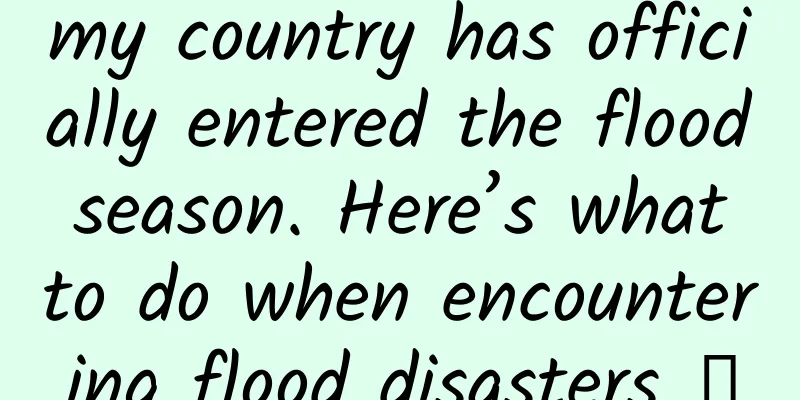my country has officially entered the flood season. Here’s what to do when encountering flood disasters →

|
The Ministry of Water Resources announced on April 1 that my country has officially entered the flood season. It is predicted that this year's flood season will be characterized by both drought and flood, with flood being more severe than drought. The seven major rivers in my country are likely to experience torrential rain and floods of varying degrees, and some areas may experience periodic droughts. Therefore, we must fully understand the characteristics and disasters of the flood season and fully master flood prevention knowledge in order to better respond to various possible flood situations. Know the characteristics of the flood season and don't panic The so-called flood season refers to the period when the water level in rivers rises due to seasonal precipitation, ice melting and snow melting. Depending on the season and the cause of the flood, it can be divided into spring flood, summer flood, autumn flood and ice flood. In spring, the climate warms up, seasonal snow melts, river ice thaws or spring rains in the river basin cause river water to rise, which is called spring flood. In northern my country, the phenomenon of rising water caused by river ice thawing in spring is called ice flood. In summer, heavy rains in the river basin or melting of mountain glaciers and snow cause river water to rise sharply, which is called summer flood. In my country, floods that occur around the dog days of summer are usually called dog days floods. In autumn, the river water rises sharply due to heavy rains, which is called autumn flood. Second, don’t underestimate the disasters during the flood season A major feature of the flood season is that the frequency and amount of rainfall gradually increase, and the safety accidents caused by it also increase accordingly. Disaster weather often occurs during the flood season, such as heavy rain, hail, lightning, strong winds, etc. Continuous heavy rain may cause secondary disasters such as river basin floods, urban waterlogging, mountain torrents, mudslides, landslides, etc., which in turn lead to various accidents. Therefore, the flood season is a critical period for meteorological disaster prevention and mitigation. Three flood prevention knowledge to remember In order to get through the flood season safely, we must enhance our awareness of flood prevention and disaster reduction and improve our emergency risk avoidance skills. For the general public, first of all, we should pay close attention to weather conditions and try to reduce unnecessary outings. If you really encounter various disasters, don't panic, and be sure to stay calm. Please keep in mind the following flood prevention tips. √What should I do in case of heavy rain? When you encounter strong winds and heavy rain indoors, the first thing to do is to close the doors and windows to prevent rain from entering the room. Do not use electrical appliances without lightning protection measures, and try to reduce the use of mobile phones. In low-lying residential and commercial areas, sandbags, straw bags, baffles, etc. can be used to block rain from entering. Once water enters a building, immediately turn off the power supply, gas valves and other equipment. If you encounter heavy rain outdoors, you must pay attention to walking safety. First, avoid various manhole covers and ditches on the road. Secondly, avoid lamp poles, electric poles, transformers, power lines and nearby trees and other objects that may be connected to electricity. Find a safe place to take shelter as soon as possible. When driving, you must pay attention to warning signs and consider detouring instead of blindly passing. When encountering heavy rain, you should choose to park in a higher place as soon as possible, and remember not to drive at risk. In the event that the vehicle stalls in the water, you must quickly judge the situation and escape in time. √What should we do when encountering urban flooding? Heavy or continuous rainfall can easily cause urban flooding. People in low-lying areas should make preparations for drainage in advance, and people in areas with serious waterlogging should make preparations for evacuation in advance. When outdoors, you should first determine the depth of the water in the depression, and do not walk in the water rashly. When walking, it is best for multiple people to support each other, or climb on the railings and walls around you to ensure safety. At the same time, be careful to avoid sewer openings and fallen electric poles that have been washed open by water. When driving and encountering a flooded depression, it is best to stop first, and do not blindly enter a flooded bridge or culvert. If necessary, choose to stay. If you are trapped, call 110 or 119 immediately to report the incident, accurately describe the location of your trap, the disaster situation, the status of people, etc., and wait patiently for rescue. √What should you do if you encounter a mudslide? In mountainous areas, especially in areas with steep terrain, the intensity of heavy rain is very likely to cause geological disasters such as mudslides. Mudslides are characterized by suddenness, fast flow, large flow, large material capacity, and strong destructive power. They are usually accompanied by heavy rain and floods. Therefore, in the season of frequent heavy rains, it is necessary to do a good job of early warning and prevention, and try to move to a relatively safe place for shelter in advance. There are usually some signs before a mudslide breaks out. Knowing them in advance can buy time to avoid danger. For example, when a landslide occurs, the trees on the mountain will make a noisy sound, and the mountain will also make abnormal mountain sounds; when the upstream river channel is blocked, the water flow in the stream will be significantly reduced; when a landslide occurs upstream, the water flow in the stream will become turbid; when the water flow suddenly increases, there will be a sound similar to an explosion in the river. Once you sense these abnormal signs, you must react in time and choose the nearest safe route to run horizontally along the hillside. Never run down the hillside or downstream along the valley exit. √What should you do if you encounter a flood head-on? If you encounter a flood and communication is cut off, you can use a variety of methods to send distress signals to the outside world, such as creating a fire, waving brightly colored clothes, collective shouting, etc. If you unfortunately fall into the water, you should try to grab fixed objects or floating objects such as rocks and tree trunks. If you receive a distress signal from the trapped person, you should rescue them while ensuring your own safety, or seek help from rescue agencies and personnel as soon as possible. |
<<: Qingming Outing Season | How to have fun in nature without going wild?
Recommend
A detailed analysis of Perfect Diary’s social media sales pitch
Perfect Diary was founded in 2016, but it only op...
Cash loan ads invaded Douyin, spending 3 million yuan in one day, revealing the list of 20 Internet finance companies
√ With 150 million daily active users, the first ...
LeTV Sports breaks the record of financing with 800 million yuan. Why is it favored by Jack Ma and Wang Jianlin?
Let's go back to 2012, when Jack Ma and Wang ...
9 examples of obtaining seed users
I often joke with my friends: Young people, don’t...
Mobile business revenue under pressure, LG and Samsung compete for high-end TV profits
High-end TVs have brought a warm touch to the per...
Want to reduce microplastics in water? Boil it before drinking丨Tech Weekly
Compiled by Zhou Shuyi This fish is only the size...
Starting from setting up stalls, let’s talk about advertising optimization techniques!
There is a lot of knowledge hidden behind the sma...
New interpretation of ROI: input-output ratio
Why do many companies go bankrupt after their cap...
How to understand a famous book?
Mixed Knowledge Specially designed to cure confus...
The 3rd Changan Automobile Technology Ecosystem Conference opens a new era of "Digital New Automobile"
On September 4, Changan Automobile held the "...
How to establish a user incentive system to enhance user stickiness?
Most mature apps now have a similar membership sy...
To brush or not to brush is not just a matter of "face"
"This was installed for us for free by Alipa...
Surpassing BYD, the new king of sea-going vehicles, Deep Blue S7 tops the list of Tyrande, a new global choice
Top of Thailand Land, a new global choice. Recent...
How much does it cost to develop a makeup mini app in Huai'an?
Is it easy to develop a Huai'an makeup mini p...
How did people prevent earthquakes and provide disaster relief in ancient times?
A brief discussion on the strategies of ancient p...









